Fujifilm X-T100 Review
Fujifilm X-T100
An excellent entry-point into Fujifilm’s X-Series cameras
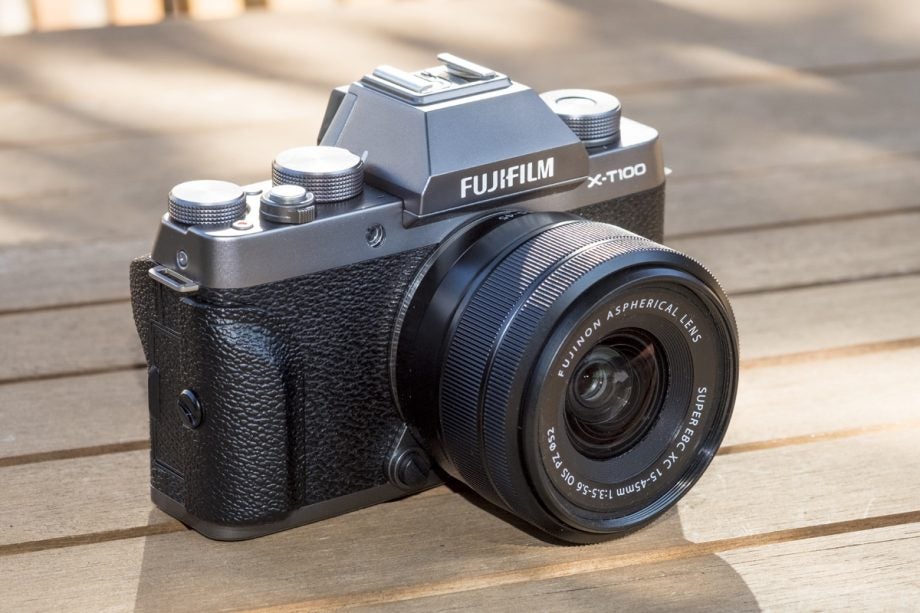
Verdict
Pros
- Excellent image quality
- Stylish design
- Easy to use
- Has both an EVF and touchscreen
- Small size
Cons
- Low frame-rate 4K video
- Average autofocus
- No weatherproofing
- Slow, noisy kit lens
Key Specifications
- Review Price: £619
- Review price: £619 (with XC 15-45mm lens)
- 24.2 megapixel APS-C sensor
- ISO 200-12,800 (100-51,200 expanded)
- 6fps continuous shooting
- 3in, 1040k-dot tiltable LCD touchscreen
- 0.39in, 2360k-dot OLED color viewfinder, 0.62x magnification
- 448g (with battery and card)
What is the Fujifilm X-T100?
Depending on how you look at it, the Fujifilm X-T100 is either the company’s most advanced camera for beginners, or its most basic premium model.
It slots into Fuji’s mirrorless X-Series lineup, between the entry-level X-A5 and the excellent X-T20. But it’s far closer to the latter in terms of specs, thanks to its electronic viewfinder, superior build and styling and assortment of manual controls.
Like the X-A5 – but unlike all X-T cameras – the X-T100 uses a 24-megapixel APS-C-sized Bayer sensor, rather than Fuji’s proprietary X-Trans, and offers 4K video at a reduced 15fps.
Price-wise, it fits squarely between the £500 X-A5 and the £879 X-T20: it will cost you £619 and comes with the XC 15-45mm kit lens.
In all regards, then, the X-T100 represents a midway point between Fuji’s two existing beginner options. So does it do enough to forge its own identity in an increasingly crowded lineup?
Related: Best mirrorless cameras
Fujifilm X-T100 – Design and features
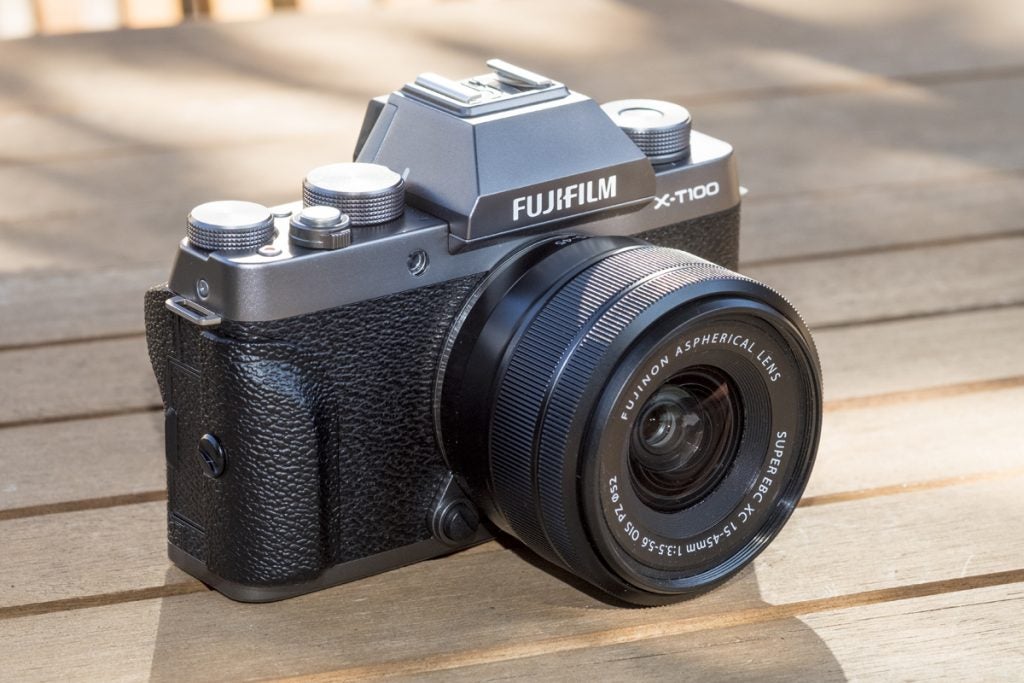
You’d be hard-pushed to find a more attractive CSC (Compact System Camera) than the X-T100, particularly at this price point.
Unlike the rangefinder-style X-A5, it’s shaped like a mini-DSLR, complete with a large viewfinder prism in the top-centre. Like the X-T20, it’s gorgeously retro without being too hipster – the kind of camera that doesn’t so much demand your attention as softly caresses your eyeballs.
It’s also beautifully built. The majority of the body is textured black plastic, but the top-plate is a classy anodised aluminium, available in a choice of three colours: Black, Dark Silver and Champagne Gold. Although not weatherproofed, it feels reassuringly solid in the hand. Indeed, it has a little more weight to it than you might expect – 450g body-only, no doubt thanks to all that metal.
That’s still light compared to many cameras, though, and it’s also impressively small. With a pancake lens in place, you’d have no problem slipping it into a jacket pocket, and it won’t attract attention on the street unless paired with one of Fuji’s bigger XF lenses.
The drawback to that small size is that some may find it too teeny to hold comfortably – particularly since it’s lacking in obvious curves. Fortunately, Fujifilm provides a clip-on grip in the box, and I’d recommend using this both for ergonomics and to ensure it doesn’t come to an untimely end on the pavement.
In keeping with the rest of the X-T range, and again unlike the X-A5, there’s room on top for three command dials. These don’t follow the pattern common to X-Series cameras, with no dedicated ISO or shutter speed controls. However, you do still get exposure compensation alongside the standard mode selector and one fully customisable dial.
There are also plenty of other options dotted around the body, including a customisable function button, a quick-settings ‘Q’ menu, four-way D-pad and selector wheel. As with most Fuji cameras, it’s a tactile delight to use.
A built-in flash is triggered via a switch on the top, and there’s a hot-shoe should you wish to add an external unit. You also get Bluetooth built in, which combines with Wi-Fi to make for a theoretically seamless connection to a smartphone. And the use of the word theoretically is deliberate.
After going through the Bluetooth setup process, the camera and your phone should automatically connect, unless the latter is already connected to a Wi-Fi network. If it is, you’ll need to go into your phone’s Wi-Fi settings and switch it to the camera.
Fujifilm X-T100 – Screen and viewfinder
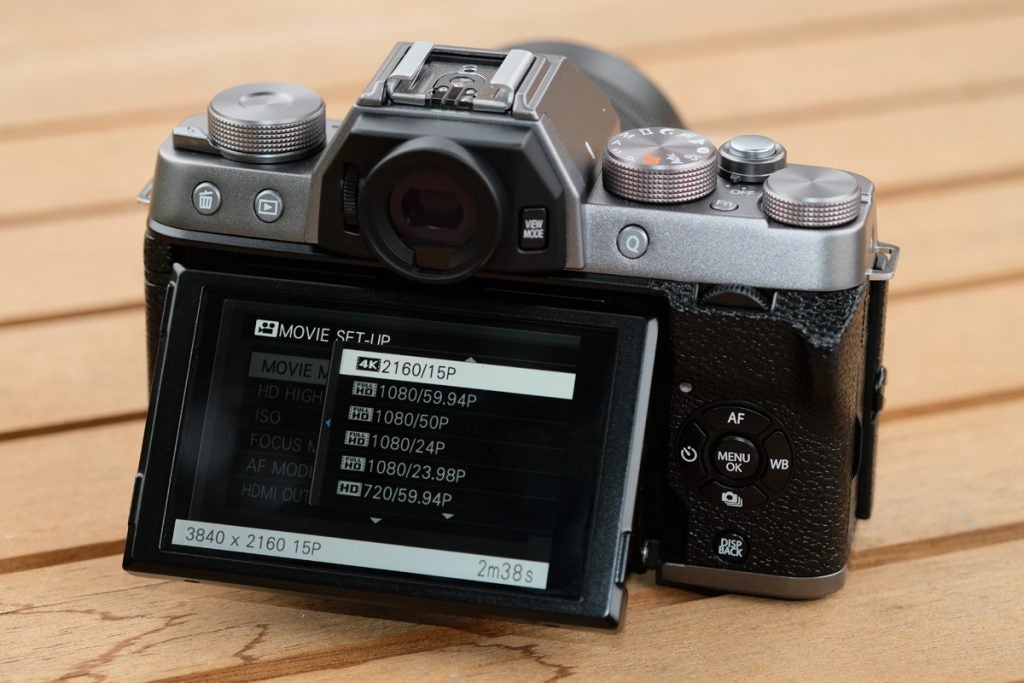
What really marks out the X-T100 as more of an X-T20 with a few missing features, rather than an X-A5 with a few extras, is the presence of an EVF (electronic viewfinder). This completely changes the way you shoot, and is a feature anyone serious about getting into photography will benefit from.
The X-T100’s EVF isn’t the best I’ve used – by some distance – but it’s a lot better than nothing, particularly when shooting in the bright sunshine the UK has been so uncharacteristically enjoying recently.
At 0.39in with 0.62x magnification it’s quite small, but at least the 2360k-dot OLED screen inside is sharp and flicker-free. I do think Fuji should have given it a larger eye-cup, though, since this almost-rimless effort lets in a lot of light.
If you’d rather use the rear display, you’ll be equally happy. The X-T100 has an excellent 3in, 1040k-dot LCD touchscreen, which tilts in three directions. It doesn’t have full 360-degree movement, but it can be flipped out vertically so you can shoot while holding the camera at your waist. It can also be turned 180-degrees horizontally for selfies or vlogging.
As a touchscreen, it works excellently within its self-imposed limits. The most common ways in which you’ll use it will be to swipe through and zoom into images during playback, and to change certain settings, such as autofocus mode. I found the latter particularly helpful, reducing the need to dive into the menus.
You can also use it to set the focal point or take a shot, but as I prefer shooting via the EVF, this is less important to me. The one thing I feel is missing is the ability to navigate the X-T100’s menus via touch – but it isn’t a major problem, particularly since there are so many physical controls on offer.
Fujifilm X-T100 – Performance
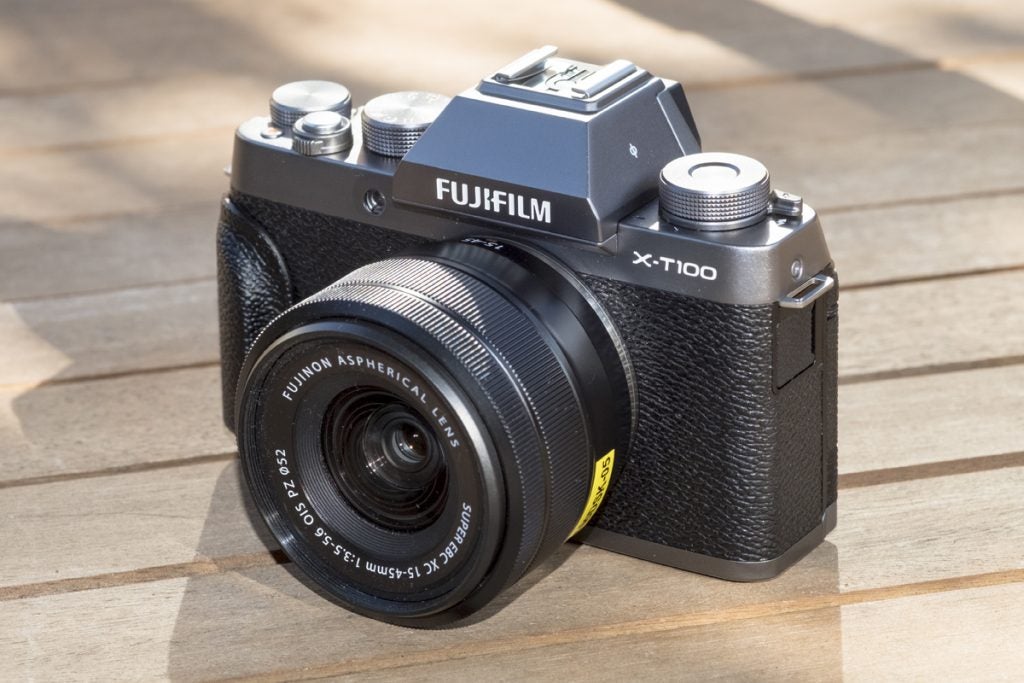
As befits its place in the Fujifilm hierarchy, the X-T100’s autofocus system is better than that of the X-A5, without troubling the X-T20 or X-T2 – let alone the flagship X-H1.
You get 91 focus points – down from 325 on the more expensive cameras – and although it uses a Phase Detection setup, it’s neither as fast nor as accurate as more expensive models.
In good light it performs well, snapping onto static subjects in an instant and generally choosing the right target in Area mode. Moving targets are a bit more hit and miss, but it will cope with children and pets – so long as they’re not speeding around like maniacs.
This isn’t a camera for pros to use at sports events, then, and it doesn’t compare to the likes of the Sony A6500, but fast action isn’t what it’s designed for. This is a camera whose primary use for many people will be taking pictures of family and friends. As such, the fact that it has an excellent Face Detection system is more important.
In dim light it has a tendency to hunt a little, particularly when using the kit lens. While I’m on that subject, the lens is also annoyingly noisy when focusing. It’s slow, too, owing to its motorised zoom, and although sharp you’ll want to replace it with one of Fuji’s superb (albeit pricey) Fujinon XF lenses as soon as you can afford to.
Burst speeds are again merely adequate: it can rattle off shots at up to 6fps in Raw mode, managing some 16 frames before the buffer fills up and the camera slows right down.
Battery life is also average. The X-T100 uses the same NP-W126S battery as other X-Series snappers, and it’s good for around 400 shots. Helpfully, though, you can charge it while it’s in the camera via micro-USB, which is a real lifesaver if you’re away from a plug socket.
Fittingly for a camera aimed at beginners, it has a wealth of intelligent auto modes designed to help you snap a great photo. The Advanced SR+ Auto mode is the main one, and works really well, analysing the scene and selecting the right settings based on the subject. It gets it right almost all of the time.
A series of self-timer options are also present, among them a Smile mode that won’t take the shot until you give it a grin, and a Buddy mode that waits until you’re next to a friend before doing its thing. None of these are flawless – the Smile mode, in particular, has an odd idea of what a smile actually looks like – but when they work, they’re fun to play around with.
In keeping with what’s fast becoming a theme here, Bluetooth is a slightly patchy affair. Pairing with a smartphone the first time is easy enough, but connecting to it again on subsequent occasions, less so. Once you’re hooked up, the Camera Remote app offers full control of the X-T100 and a fast image transfer, and only makes you wish the connection process was slicker.
Fujifilm X-T100 – Image quality and video

The X-T100 really shines when it comes to stills. Its 24.2-megapixel APS-C CMOS sensor is super-sharp and digs out incredible detail, only starting to drop when you push past ISO 3200. Just look at the photo I took of a tiny sea thing on the beach (below): this was shot handheld with the kit lens, and yet you can make out the creature’s beady eyes and every grain of sand below it.
I was interested to see how shots compared to those taken with a more expensive X-Trans camera, so I pitched it directly against the X-T2. Small differences are apparent, with photos from the more expensive camera a tiny bit sharper and more colourful, but there’s very little in it.

Noise control is excellent, with ISO 1600 barely showing any loss of resolution compared to ISO 200. I’d have no concern shooting right up to 6400 and even 12800 is usable at a pinch. Pushing to ISO 12800 introduces increased noise, but could be used in an emergency if it’s a toss up between capturing a sharp subject over it being blurred.
Colour is also well handled, and as a further bonus the majority of Fuji’s superb Film Simulation modes are present here. Stick it in Vivid and they’ll really pop, or go for Classic Chrome for a moody look.

Video is less consistent, mainly because the 4K mode is restricted to a paltry 15fps, resulting in jerky footage that for most people is unlikely to be worth the resolution boost.
Instead, I’d stick with 1080p, which is available in up to 60fps and is sharp and well-exposed. As with stills, tracking isn’t perfect, but it will be good enough for the camera’s likely target audience – just not for dedicated extreme sports YouTubers.
The high-speed movie mode is a nice extra, though: you can slow things down by up to 4x, and the results are fascinating. So long as you shoot something that looks good in slow-motion.
[videoai]Why buy the Fujifilm X-T100?
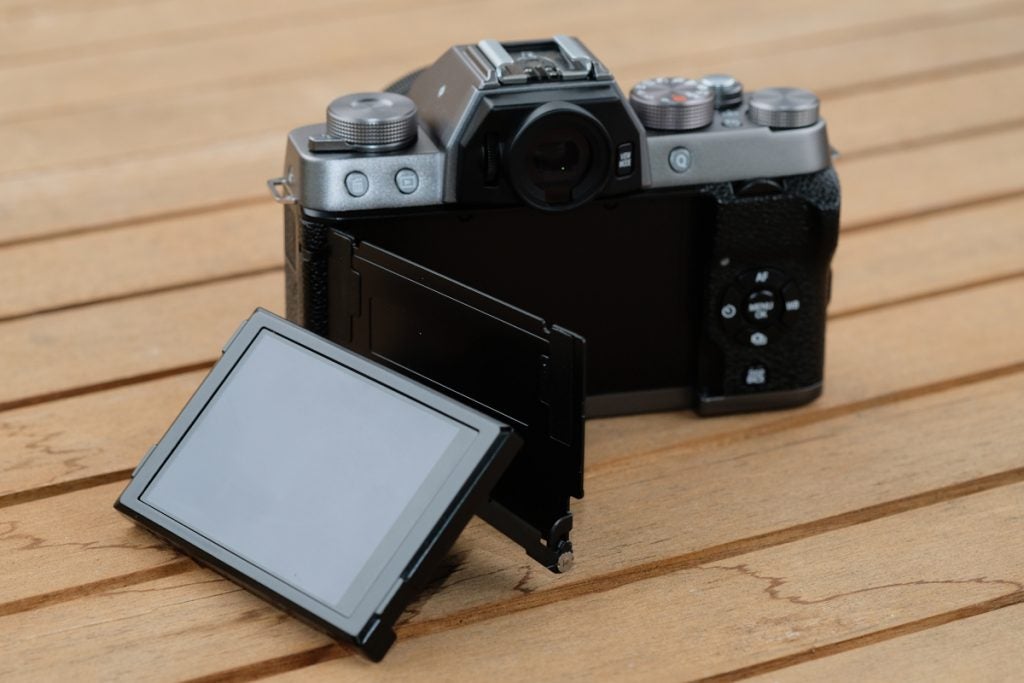
The X-T100 would make a great first ‘proper’ camera for anyone whose Instagram habit has turned into an addiction (assuming it’s the taking photos part you like, rather than the showing off bit).
The combination of retro styling and premium build in a compact body makes it a lovely object to own and use, and you’d have to spend a lot more to better the photos it takes.
Compromises have clearly been made to keep the cost down, but there’s nothing here to send you running for the hills. Its autofocus limitations can be worked around, and while the 4K video is barely worth having, Full HD footage is a worthy stand-in. Use the X-T100 with a wide-angle lens and a dedicated microphone plugged into its external port, and it could be a capable vlogging camera too.
Serious snappers will be better served by spending a bit extra on the X-T20, but between this camera and the X-A5 it’s a no-brainer: it seems £120 buys you a whole lot more in Fuji-land.
Verdict
More a cut-price Fujifilm X-T20 than a beefed-up X-A5, the X-T100 is an excellent entry-point to Fuji’s X-Series cameras. It looks great, takes wonderful pictures and doesn’t cost a fortune. Win-win-win.
The rivals
Fujifilm X-T20
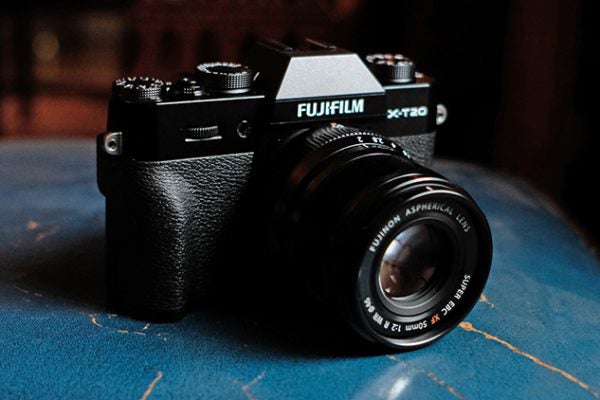
Spend a little more on the Fujifilm X-T20 and you’ll enjoy a serious jump in features. There’s proper 4K video is here, plus a far more advanced autofocus system, which is built around the X-Trans sensor – one of the best around when it comes to both colour and resolution.
All of that, and in a body that’s actually slightly smaller than the X-T100’s but every bit as attractive.
Olympus O-MD E-M10 III
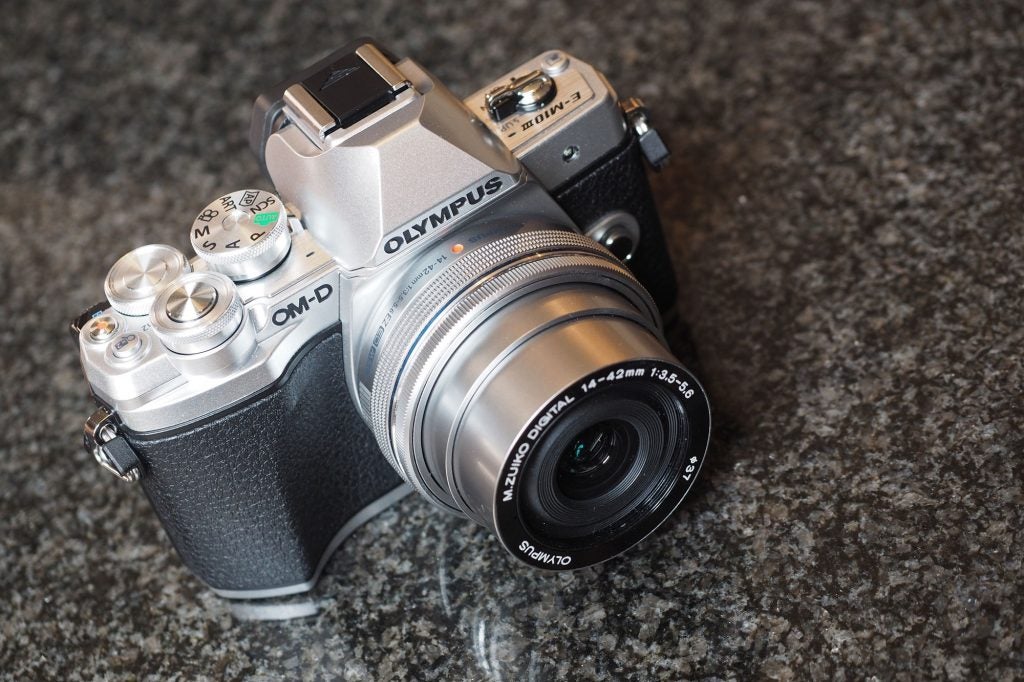
On the face of it, the third version of Olympus’ stripped back E-M10 camera has several advantages over the X-T100. Built-in image stabilisation is the big one, but a more mature autofocus system, faster burst shooting and 4K video at an actually usable 25fps are all in its favour too.
Only the E-M10 III‘s sensor counts against it: 16 megapixels plus the smaller Micro Four Thirds chip doesn’t quite cut it with the best these days.
Trusted Score
Features
| Megapixels (Megapixel) | 24.2-megapixels |
| Image Sensor | APS-C CMOS |
| Shutter speed | 30-1/4,000sec (4-1/32,000sec via electronic shutter) |
| Max output resolution | 6000 x 4000 pixels |
| Exposure metering | Multi, Spot, Average |
| Exposure compensation | +/-5EV in 1/3EV steps |
| ISO settings | ISO 200-12,800 (100-51,200 expanded) |
| LCD Monitor | 3in, 1.04million-dot tiltable LCD touchscreen |
| Viewfinder | 0.39in, 2360k-dot OLED color viewfinder, 0.62x magnification |
| Drive modes | 6fps continuous shooting |
| Image formats | JPEG, RAW |
| Video (max res/format) | 4K (3840x2160), Full HD (1920x1080), HD (1080x720) |
| Memory card slot | SD, SDHC, SDXC (UHS-1 compliant) |


